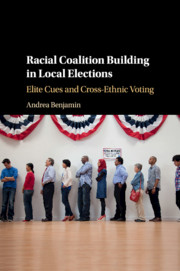Book contents
- Racial Coalition Building in Local Elections
- Racial Coalition Building in Local Elections
- Copyright page
- Dedication
- Contents
- Figures
- Tables
- Acknowledgments
- Introduction
- 1 The Co-ethnic Elite Cues Theory
- 2 An Experimental Test of the Co-ethnic Elite Cues Theory
- 3 The Co-ethnic Elite Cues Theory and Elite Black–Latino Coalitions
- 4 The Co-ethnic Elite Cues Theory and Racial Attitudes
- Conclusion
- Elections Appendix
- References
- Index
- References
References
Published online by Cambridge University Press: 04 July 2017
- Racial Coalition Building in Local Elections
- Racial Coalition Building in Local Elections
- Copyright page
- Dedication
- Contents
- Figures
- Tables
- Acknowledgments
- Introduction
- 1 The Co-ethnic Elite Cues Theory
- 2 An Experimental Test of the Co-ethnic Elite Cues Theory
- 3 The Co-ethnic Elite Cues Theory and Elite Black–Latino Coalitions
- 4 The Co-ethnic Elite Cues Theory and Racial Attitudes
- Conclusion
- Elections Appendix
- References
- Index
- References
- Type
- Chapter
- Information
- Racial Coalition Building in Local ElectionsElite Cues and Cross-Ethnic Voting, pp. 168 - 177Publisher: Cambridge University PressPrint publication year: 2017



